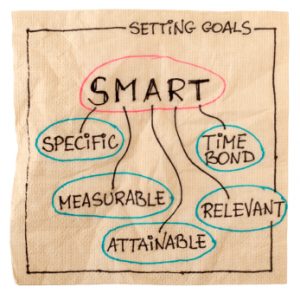Here we find ourselves again, welcoming a new year and all it will bring into our lives. About 45% of Americans take this opportunity to set the tone for the rest of the year by making New Year’s resolutions; whereas, 38% of Americans never set specific goals for the New Year. It’s easy to see why so many people opt out of making resolutions, because only 8% of people actually achieve their goal. As with most ventures, solid preparation in setting goals and resolutions will help people follow through on their goals.
This time presents an excellent opportunity to teach young athletes about goal setting. The process of setting goals guides athletes to understand their current level of skill and achievement and their ability to progress. Establishing goals may seem simple, but to do so effectively requires an understanding of the types of goals, especially related to athletics, and the process to set, monitor, and accomplish an objective.
Types of Goals
Outcome Goals are related to the big picture of athletics and competition, such as winning a game or making it onto a particular team. It is important to realize that oftentimes, athletes have very little control over the external factors which could affect their outcome goal. This type of goal is important as it can serve as motivation for an athlete as they may encounter obstacles in accomplishing the performance and process goals, which we describe below. An outcome goal is the “prize” in the saying, “eyes on the prize.” An example scenario for this would be for a young woman who decides she wants to be on her high school basketball team.
Performance goals are excellent benchmarks for mapping one’s progress as they strive to meet their outcome goal. Let’s follow the illustration of the young basketball player who wants to be on her high school’s team. Tryouts involve a variety of challenges, such as running a mile in under 14 minutes or being able to make a certain percentage of free throws. The athlete would establish these measurable targets as her performance goals.
Process goals relate to the everyday aspects of meeting the larger outcome goals, and they are the “how” in accomplishing performance goals. Unlike outcome goals, athletes are typically able to have complete control as they strive to accomplish process goals. In the case of the young basketball player, her stance when on the free throw line or her form when running, can impact the performance goals that will allow her to make it on the team. This is where practice, determination, and sometimes frustration come in. An athlete may feel discouraged if they have difficulties making progress with these goals, and that is why it is always important to help them realize these are steps in a bigger picture.
Goal-Setting Process

Preparation and visualization are two essential elements in successful goal planning. Dr. Steven Ungerleider, founding board member for GSD and sport psychologist, has spent over 35 years working with athletes to identify and achieve their goals. About his experience he says, “Since Olympians are very focused and disciplined, it was usually easy to write out a visualization plan, how to do it, when, practice, and implementation. Usually athletes reported good short-term and long-term results.”
Experts and researchers have identified an effective process in goal setting which can lead to more success. They’ve even come up with a clever acronym to help us through the process: SMART. Goals should be specific, measurable, attainable, relevant, and time specific. Keeping these guidelines in mind, there are also steps one should take in identifying each goal.
- Write it Down – Try expressing your goal in present tense, for example, “I run two miles in under 14 minutes.” Doing so allows you to shift your reality and actualize your goal. Also, focus on positive and affirmative language, rather than negative tones. Instead of saying what you won’t do (“I won’t stay up late.”), write down what you will do (“I will be in bed by 9 pm each night.”).
- Determine Measurement for Goal – In order to track success, it is imperative to define what “success” means. Whether you want to eat more nutritious meals before games and practices or if your goal is to be prepared for practice each day, there is a way to measure it. For example, if your goal is to eat better, you can track your nutrition by the numbers. If you want to be prepared for practice each day, set your measurement to be how early you arrive to practice or how long it takes you to get ready for practice.
- Set a Time Limit – Sure, if your goal is to make the US Olympic swimming team, then your timeframe could be many years. But for EACH goal (outcome, performance, and process) set a deadline to meet it. Not only does this keep you on track, but it creates a challenge AND sense of accomplishment as you meet goals in succession.
- Identify Obstacles – For the athlete whose performance goal is to be prepared for daily practice, what kinds of hindrances might he encounter? After-school club meetings, overwhelming school projects, illness, etc. In a perfect world our schedules would run without interruption. But reality requires us to recognize situations which could possibly get in the way of us reaching our daily goals.
- Overcome Obstacles – Okay, so now you know that your lack of knowledge about the proper form during running is a bit of a hindrance to you shaving off some time from your two miles. How will you get around this? Several options await you, such as consulting a coach or professional to help you, researching on the internet, video recording yourself run to examine your current form, etc. With each hurdle you recognize, create a plan for leaping over it and moving forward.
- Review Goals – Now that you’ve written everything down, read over it. Do the goals align and make sense? Is there anything missing from your list of obstacles?
- Monitor Progress – Track your measurable objectives and evaluate your progress. If you are trying to reduce your two mile run time by 3 minutes, write down your time for each run. Figure out a reward system if that helps, too.
Other Tips for Setting Goals
- Prioritize goals
- Challenge yourself
- Be specific
- Use a goal-setting worksheet
- Involve others – tell your coach, parents, or teammates about your goal
Keep it Together
Okay, you may be feeling overwhelmed at this point. Identifying the types of goals, working through all of the steps, and keeping other tips in mind – it is a lot. But it’s worth it. Coaches, parents, teachers, and teammates can be helpful in organizing your plan. Also, try using a goal-setting worksheet to visualize your goal. Print multiple copies and keep them in prominent places, such as your school notebook, bathroom mirror, or locker. Give it a try, and see if your success is different when you map your goals out in a careful fashion, and above all: Keep your eyes on the prize!


